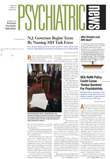Patients at high risk for suicide may be candidates for early use of electroconvulsive therapy (ECT), rather than waiting to be stepped through other, sometimes less effective, treatments first, according to first results from an ongoing multicenter study.
“The efficacy of electroconvulsive therapy in treating depression is largely ignored in treatment algorithms, limiting the chance that severely ill, depressed patients will get available effective treatment,” wrote Charles Kellner, M.D., and 15 colleagues in the May American Journal of Psychiatry.
The Consortium for Research in ECT Continuation ECT Study admitted 444 patients with unipolar depression, of whom 68 percent were women and 92 percent white; 30 percent had a psychosis diagnosis. Of those, 355 completed the study, with dropouts being counted as nonremitters. They recorded an average Hamilton Depression Rating Scale score at baseline of 35.1. A review of each patient's history showed that the severity of their illness and their resistance to prior treatment indicated ECT, said Kellner in an interview.
Based on item 3 of the Hamilton scale (expressed suicidal intent), the patients were stratified into two groups. Those with low suicidal intent (n=313) had scores of 1 or 2 on item 3, while those with scores of 3 or 4 (n=131) had high expressed suicidal intent. Of the latter group, 118 had a score of 3, indicating suicidal thoughts, actions or gestures. Another 13 patients scored a 4, indicating that they had made a suicidal attempt.
All 355 patients received an acute course of bilateral ECT sessions three times a week until they remitted or were declared resistant to ECT, or they chose to stop. Patients underwent an average of eight treatments, said Kellner. If they remitted and remained in remission for a week, they were randomized to one of two groups in the continuation phase of the trial.
Continuation therapy in the trial's pharmacotherapy arm included nortriptyline plus lithium. Continuation ECT therapy consisted of bilateral ECT weekly for four weeks, biweekly for eight weeks, and monthly for two months.
High Remission Rate Found
The remission rate for depression was 86 percent for the 355 patients who completed treatment, or 69 percent if dropouts were included as nonremitters. Of the 131 patients in the highly expressed suicidal intent group, the item 3 score dropped to 0 for 106 patients (81 percent). The item 3 ratings of the 13 patients with a score of 4 (suicide attempt) all declined to 0, although seven of these patients rebounded to higher scores by the final rating.
Expressed suicidal intent resolved to 0 significantly more often among patients 50 years of age or older, compared with younger patients, said the researchers. Two white male outpatients, ages 76 and 80, committed suicide during the study. They had completed the acute ECT phase of the trial and had baseline scores of 0 or 1 on item 3 of the Hamilton scale.
Benefits May Be Short Lived
“We find the benefits of ECT to be immediate, but they may not persist unless treatment is sustained,” wrote Kellner and his colleagues. “More intensive and extensive treatment is needed to consolidate the benefits of antidepressant treatment.”
Clinicians would indeed like to see whether such immediate outcomes can be sustained over the longer term of the full trial of maintenance ECT.
“These were very depressed people, and the researchers used highly reliable raters and applied rigorous standards,” commented Laurence Guttmacher, M.D., chief of psychiatry and acting clinical director at the Rochester Psychiatric Center in Rochester, N.Y., in an interview with Psychiatric News. “The major finding, that ECT appears to be helpful with suicidality, reinforces the importance of this treatment modality for seriously depressed patients.”
A lack of a concurrent control group may represent a limitation, however, since outcomes were compared with older studies of patients on antidepressant medications, said Guttmacher, who was not affiliated with the study.
The consortium is preparing two more articles for publication, Kellner told Psychiatric News. One will cover the outcomes of maintenance ECT therapy, and the other will deal with cognitive side effects. He has already reported at medical meetings that a preliminary analysis shows no difference in relapse rates between continuation ECT and medication treatment.
“The remission rates are higher than placebo, but still not good enough,” he said. “So we have to do better.”
In general, ECT should play a more prominent role earlier in treating depression, said Kellner and colleagues. ECT is too often considered as a last resort, rather than as a first-line treatment, a status that some states have even written into law. ECT's controversial history and the consequent reluctance of patients to accept it without trying other alternatives may also be a barrier to its increased use.
“Whatever the objections to the use of ECT may be, the present data on the rapid resolution of expressed suicidal intent warrant greater attention in evidence-based treatment algorithms,” said the researchers. Clinicians should therefore differentiate treatment options based on some measure of expressed suicide intent, they said.
Am J Psychiatry 2005 162 977
